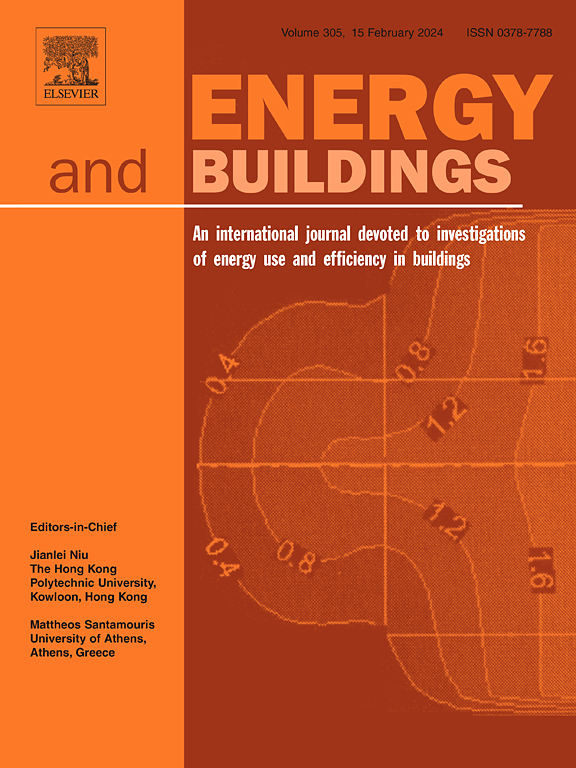Building performance optimization through sensitivity Analysis, and economic insights using AI
IF 6.6
2区 工程技术
Q1 CONSTRUCTION & BUILDING TECHNOLOGY
引用次数: 0
Abstract
Optimizing building designs for energy efficiency and occupant comfort presents significant challenges due to the complex and often conflicting requirements of various stakeholders. Consequently, this study conducts a multifaceted sensitivity and economic impact analysis that aims to improve building performance in terms of energy efficiency and occupant comfort by implementing machine learning techniques. Using a broad dataset comprising of 12,000 energy simulation runs for Tvedestrand Upper Secondary School in Norway, several machine learning models were employed with Multi-Layer Perceptron outperforming the others. In addition, several sensitivity analysis methods were used to explore the influence of individual parameters on building performance. The analysis reveals that ventilation rate, room depth, U-value of the facade, and heat gains significantly affect energy consumption. Economic impact analysis was also carried out to compare the cost-effectiveness of traditional HVAC systems with Building Management System (BMS) HVAC solutions. The BMS HVAC system shows significantly lower operational costs over time, with investment costs averaging around 1200 Norwegian kroner (NOK)/m2 and operational costs of approximately 150 NOK/m2 per year. Sensitivity analysis under different economic scenarios highlights the economic viability of the BMS HVAC system. This study identifies optimal building parameters that balance energy efficiency and thermal comfort, achieving total energy consumption between 11.05 and 22.51 kWh/m2 and zero discomfort hours (h > 26 °C). In sum, the findings offer valuable insights for stakeholders, enabling informed decisions about sustainable building design and energy efficiency improvements, ensuring both technical soundness and financial viability under a wide range of conditions, while using the tested tools.
通过灵敏度分析优化楼宇性能,利用人工智能洞察经济形势
由于各利益相关方的要求错综复杂,往往相互冲突,因此优化建筑设计以提高能效和居住舒适度面临着巨大挑战。因此,本研究进行了多方面的敏感性和经济影响分析,旨在通过采用机器学习技术,提高建筑在能效和居住舒适度方面的性能。通过对挪威 Tvedestrand 高级中学 12,000 次能源模拟运行的广泛数据集进行分析,采用了多种机器学习模型,其中多层感知器模型的性能优于其他模型。此外,还采用了几种敏感性分析方法,以探索各个参数对建筑性能的影响。分析结果表明,通风率、房间深度、外墙 U 值和热增益对能耗有显著影响。此外,还进行了经济影响分析,以比较传统暖通空调系统与楼宇管理系统(BMS)暖通空调解决方案的成本效益。随着时间的推移,BMS 暖通空调系统的运营成本明显降低,投资成本平均约为 1200 挪威克朗(NOK)/平方米,每年的运营成本约为 150 挪威克朗/平方米。在不同的经济情况下进行的敏感性分析凸显了 BMS 暖通空调系统的经济可行性。这项研究确定了平衡能源效率和热舒适度的最佳建筑参数,实现了 11.05 至 22.51 kWh/m2 的总能耗和零不适时间(26 °C)。总之,研究结果为利益相关者提供了宝贵的见解,使他们能够就可持续建筑设计和能效改进做出明智的决策,在使用测试工具的同时,确保在各种条件下的技术合理性和财务可行性。
本文章由计算机程序翻译,如有差异,请以英文原文为准。
求助全文
约1分钟内获得全文
求助全文
来源期刊

Energy and Buildings
工程技术-工程:土木
CiteScore
12.70
自引率
11.90%
发文量
863
审稿时长
38 days
期刊介绍:
An international journal devoted to investigations of energy use and efficiency in buildings
Energy and Buildings is an international journal publishing articles with explicit links to energy use in buildings. The aim is to present new research results, and new proven practice aimed at reducing the energy needs of a building and improving indoor environment quality.
 求助内容:
求助内容: 应助结果提醒方式:
应助结果提醒方式:


